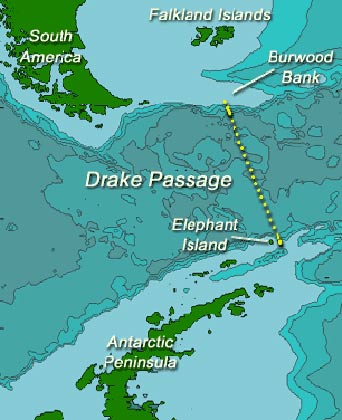When you hold your thumb over the end of a garden hose, the flow changes from a gentle stream to a high-speed jet. The same amount of water is trying to escape through a smaller opening, so it has to move faster.
 Map showing the Drake Passage. Credit: National Oceanography Centre
Map showing the Drake Passage. Credit: National Oceanography Centre The same thing happens off the tip of South America. An ocean current that circles the globe squeezes through a 500-mile-wide gap known as the Drake Passage. The current not only speeds up, it also creates powerful eddies. Combined with strong winds and violent storms, that makes the Drake Passage one of the roughest patches of sea on Earth.
The passage is named for Sir Francis Drake, a 16th-century British adventurer. As he tried to navigate through a narrow passage along the coast of Chile, his ship was blown far to the south, hinting that there was a wider passage between the Atlantic and Pacific. Drake didn’t sail through it, though -- no one did until many years later.
The passage allows a cold current to circle Antarctica from west to east. This current might be responsible for Antarctica’s cold.
Long ago, the continent was warm and damp. But about 40 million years ago, the motions of Earth’s crust opened the passage.
Researchers say that with nothing to impede it, the cold current began circling Antarctica. The cold waters blocked warmer waters and triggered other changes in the environment around Antarctica -- and perhaps the rest of the world as well. The continent quickly turned into a frigid desert -- separated from South America by the Drake Passage.

